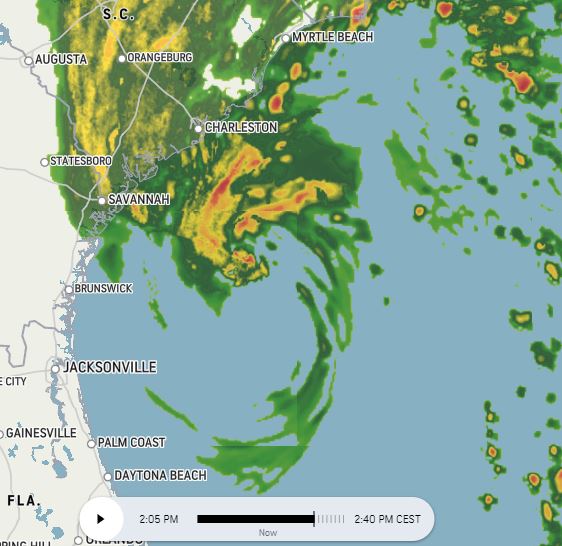
#ExtremeWeather #ClimateChangeNow
#HurricaneIAN Update thread.
Near live 6hr satellite imagery #IAN beginning its exit of Florida over Cape Canaveral and the Kennedy Space Center. And it looks like it started strengthening significantly before it's center crossed the coast.
#HurricaneIAN Update thread.
Near live 6hr satellite imagery #IAN beginning its exit of Florida over Cape Canaveral and the Kennedy Space Center. And it looks like it started strengthening significantly before it's center crossed the coast.
https://twitter.com/althecat/status/1575446703515340802
This wider angle view helps put the storm into wider perspective, in particular its size, and the importance and significance of the massive convective area to the East of Florida from which #TSIan #HurricaneIAN is being fuelled.
The big question now is how will #HurricaneIAN interact with this atmospheric river as it crosses the Atlantic heading towards the Carolinas, specifically, will this extremely complex moist air field strengthen or inhibit intensification.
The NHC experts & the ECMWF and GFS numerical physics models, statistically very accurate over 2-3 days [Citation: @RyanMaue] agree. The transit is expected to take 3 days. So this is the probable path. 



However not behaving as expected is a feature with #HurricaneIAN. Also the proximity to land, slow speed, unusual size and track record of this big-wet-hurricane means it is not a certainty.
Then there is the unusual adjacent & colossal atmospheric river which #HurricaneIAN created which will bring heavy rain to Europe soon, starting in the UK and Ireland tomorrow. 



And the experimental short range HRRR model which did quite a good job of picking the correct exit point from Florida.
Either way we ought to know for sure pretty quickly.
Right now the radar imagery suggests the exit angle from Florida is on the official track line.
But if #HurricaneIAN intensifies, slows down, speeds up, or heads more eastwards... there are other possibilities.


Right now the radar imagery suggests the exit angle from Florida is on the official track line.
But if #HurricaneIAN intensifies, slows down, speeds up, or heads more eastwards... there are other possibilities.



In this one - the EPS is the ECMWF ensemble, which the JTWC seems very fond of and is a very solid model you can see a bunch of ensemble members (in red) which show the storm strengthening.
However the cluster is vert tight and in agreement with the GFS ensemble.
However the cluster is vert tight and in agreement with the GFS ensemble.

This Florida radar loop shows a fairly large circulation seemingly working hard to close a circle.
And this clean satellite picture on sunrise this morning confirms that there is a fairly attempt being made by #HurricaneIAN to reorganise with astonishing bursts of convection all the way up the East Coast of Florida to Virgina.
And a wider view.
• • •
Missing some Tweet in this thread? You can try to
force a refresh




























